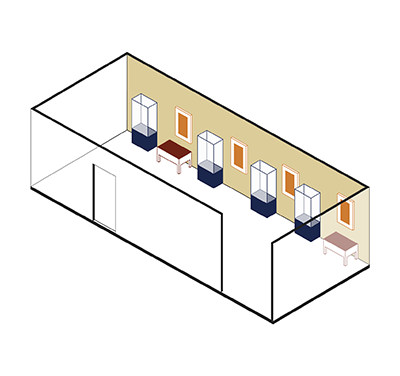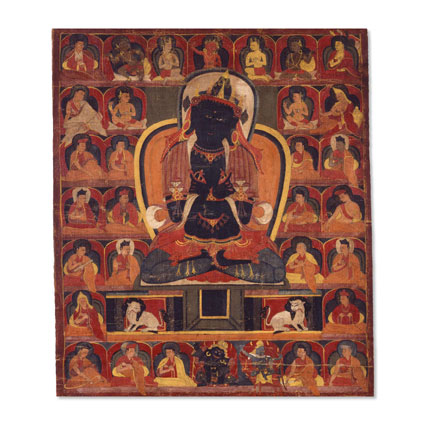Primordial Buddha Vajradhara with Teachers of the Kagyü Lineage
See it in the Museum

India and Nepal
Orientation 3
Wall object 11

ABP 005
Code: ABP 005
Country: Tibet
Style:
Date: 1300 - 1400
Dimensions in cm WxHxD: 34.5 x 41
Materials: Gouache on cotton
The centre iconography of this Tibetan painting depicts Vajradhara, surrounded by teachers and monks of the Kagyupa Lineage.
Vajradhara
Vajradhara is the ultimate Primordial Buddha, or Adi Buddha, according to the cosmology of Tibetan Buddhism. Vajradhara displaced Samantabhadra Buddha in Gelug and Kagyu mythologies, but is metaphysically equivalent. Achieving the 'state of vajradhara' is synonymous with complete realisation.
From the primordial Vajradhara/Samantabhadra were manifested the Five Wisdom Buddhas (Dhyani Buddhas):
* Akshobhya
* Amoghasiddhi
* Amitabha
* Ratnasambhava
* Vairocana
Vajradhara and the Widsom Buddhas are often subjects of mandala.
Vajradhara and Samantabhadra are cognate deities with different names, attributes, appearances and iconography. Both are Dharmakaya Buddhas, that is primordial Buddhas, where Samantabhadra is unadorned, that is depicted without any attributes. Conversely, Vajradhara is often adorned and bears attributes, which is generally the iconographic representation of a Sambhogakaya Buddha. Both Vajradhara and Samantabhadra are generally depicted in yab-yum unity and are primordial buddhas, embodying void and ultimate emptiness
Vajradhara is the ultimate Primordial Buddha, or Adi Buddha, according to the cosmology of Tibetan Buddhism. Vajradhara displaced Samantabhadra Buddha in Gelug and Kagyu mythologies, but is metaphysically equivalent. Achieving the 'state of vajradhara' is synonymous with complete realisation.
From the primordial Vajradhara/Samantabhadra were manifested the Five Wisdom Buddhas (Dhyani Buddhas):
* Akshobhya
* Amoghasiddhi
* Amitabha
* Ratnasambhava
* Vairocana
Vajradhara and the Widsom Buddhas are often subjects of mandala.
Vajradhara and Samantabhadra are cognate deities with different names, attributes, appearances and iconography. Both are Dharmakaya Buddhas, that is primordial Buddhas, where Samantabhadra is unadorned, that is depicted without any attributes. Conversely, Vajradhara is often adorned and bears attributes, which is generally the iconographic representation of a Sambhogakaya Buddha. Both Vajradhara and Samantabhadra are generally depicted in yab-yum unity and are primordial buddhas, embodying void and ultimate emptiness
Bock, Etienne; Falcombello, Jean-Marc; Jenny Magali, 2022. Trésors du Tibet. Sur les pas de Milarépa.. Paris: Flammarion. P. 208-209
Sèngué, Tcheuky, 2002. Petite Encyclopédie des Divinités et symboles du Bouddhisme Tibétain. Editions Claire Lumiere . Pp. 106-107 - Vajradhara

